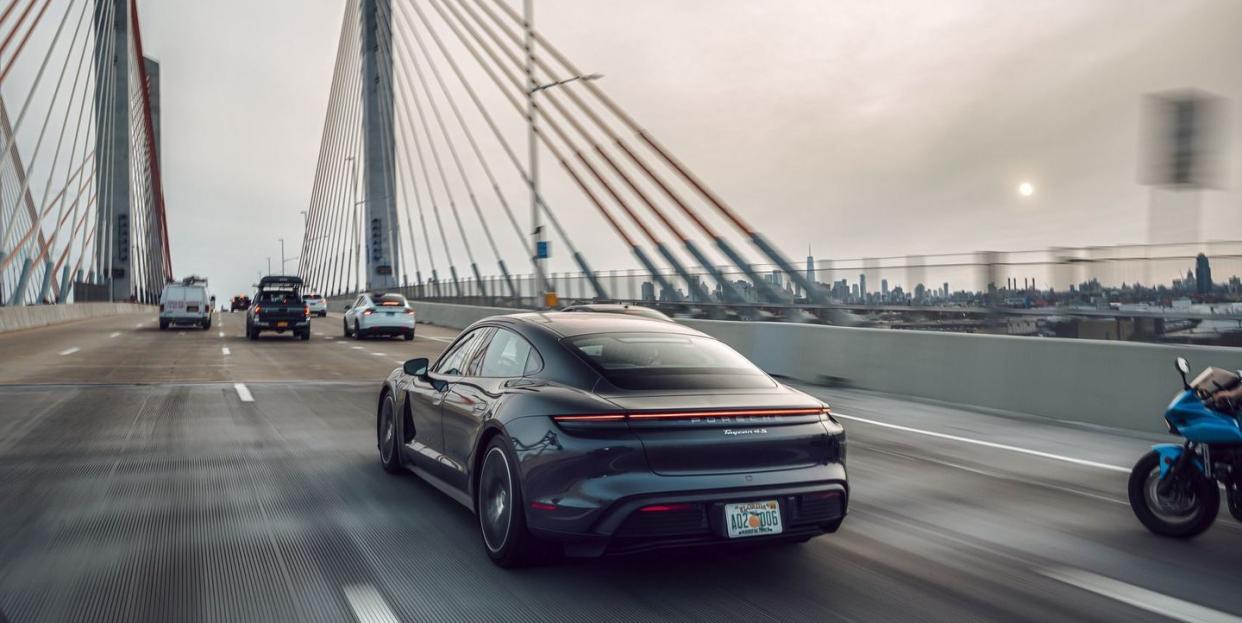What to Consider When Planning an EV Road Trip

The all-electric road trip is no longer a wholly novel adventure. For years now, countless Americans have made long-distance trips in battery electric vehicles without issue. But planning an all-electric expedition can't be done with the same approach you'd use driving a gas car. You need to weigh some additional variables.
Charging Stops
Forgive the obviousness, but this is the big one. Everyone knows you must plan around charging, but there's nuance to what has to be considered. That starts with the charging network.
Your Tesla may be able to plug into other brands' fast chargers, but you may need an adapter. With an Audi, you know you can't use Tesla Superchargers, but have you installed the apps and secured accounts with charging services to be used along the way? An Electrify America account doesn't cover every other brand's chargers.
Speed and cost are also considerations. Stations that bill based on time incentivize finding the fastest charger a vehicle can use, while ones that bill per kWh will mean balancing cost with charging time. Make sure to read reviews and user comments on charging station finding apps, as some may be in private-access areas or paid parking garages. On one trip in New York City, a staffer discovered that—when factoring in the cost of entering the garage that housed the paid fast charger—charging a Chevy Bolt was more expensive than fueling up a gasoline-powered vehicle.
Develop some contingency plans too. An EV road trip plan should not assume that every charger will be unoccupied, working, and delivering its rated output. Especially outside of the Tesla network, the public chargers in the U.S. have a well-earned reputation for spottiness. Don't plan a route that has no alternative charging options if the fastest, most convenient charger is offline.
Weather and Elevation
Let's say your EV can go 200 miles on the EPA test cycle. That's a good guiding principle, but it's a gamble -- a big gamble -- to plan 195 miles between charging stops. If you're hauling hundreds of pounds of furniture or gear, if you're gaining thousands of feet of elevation, or if you're driving in freezing weather, you're going to see seriously diminishing charge range. Below freezing, assume a 30 percent range penalty.
Driving Style and Climate Control
Using the air conditioning or heat in an EV will dramatically affect on range. So minimizing the strain both systems impose is vital. In cold weather, heated seats will help the driver and passengers put up with a lower temperature in the cabin instead of blowing heated air. When it's hot, close the sun shades to reduce the solar load and give your A/C system some relief. Either way, know going in where you're likely to encounter extreme hot or cold, and account for the range that come with both. Many EVs will pre-condition their interiors (heated or cooled) before being taken off the home charger too. It takes less energy to sustain an established temperature than to achieve that temperature from an extreme.
The road trip starts with an advantage if the vehicle is readied for comfort before it moves.
Battery Pre-Conditioning
As you approach your charging stop, some EVs allow you to pre-condition the battery for shorter charge time. This will consume energy in the short term, but increase the rate at which you can replenish it, so it's usually worth it. It's especially worthwhile if the weather is cold, as batteries do not like charging in the cold.
How to Spend Charging Time
If a vehicle is slow to charge or if your trip requires level 2 charging instead of speedy fast zapping, spend that time wisely. Road trips are tiring and inconvenient. Replenishing yourself during charging stops is key.
This isn't wasted time. You can do anything during your charge time, so long as it doesn't require your car to move. Even if a charger is further from your route, it may be worth the detour if it has high-quality food options nearby, good entertainment options, or places to shop and run errands. A one-hour charging block is a good excuse to do things that you've been putting off, like swinging through the post office or renewing your license. Many of these things don't have to happen close to home.
It also gives you a chance to eat a real meal, rather than just stuffing yourself with beef jerky while cruising at 80. Plan stops near good restaurants, pack a picnic basket with high-quality food from home, or stock up on fresh food at a grocery store.
If you need to kill a ton of time while you charge, find a hotel or AirBnb with a charger. Any Level 2 charger should top off even a large battery overnight.
Get the Apps
There are many apps for charging and route planning. All the major charging networks have their own, and knowing how to use them before you get to the charger is important. Know the app before relying upon it.
There are also brand-agnostic planning apps. A Better Route Planner is one the R&T staff has used for our more ambitious EV road trips, but a search for the best EV route planning apps will yield hundreds of results. Spend some time seeing which one works for you, which one has the best reputation, and which one provides all of the information you need. Some apps may be better for specific regions than others. Do some research.
Your best option may ultimately be the route planner built into the navigation of many EVs. Look to model-specific online forums to find out what the limits of your vehicle's brains are. Many are useful tools, but few offer the flexibility and information of a dedicated route planner. It's best to use both to inform and confirm each other.
You Might Also Like
